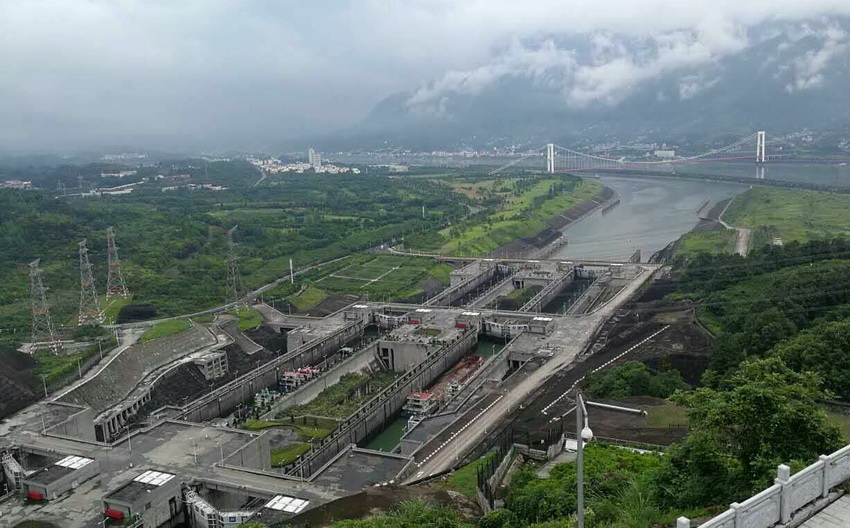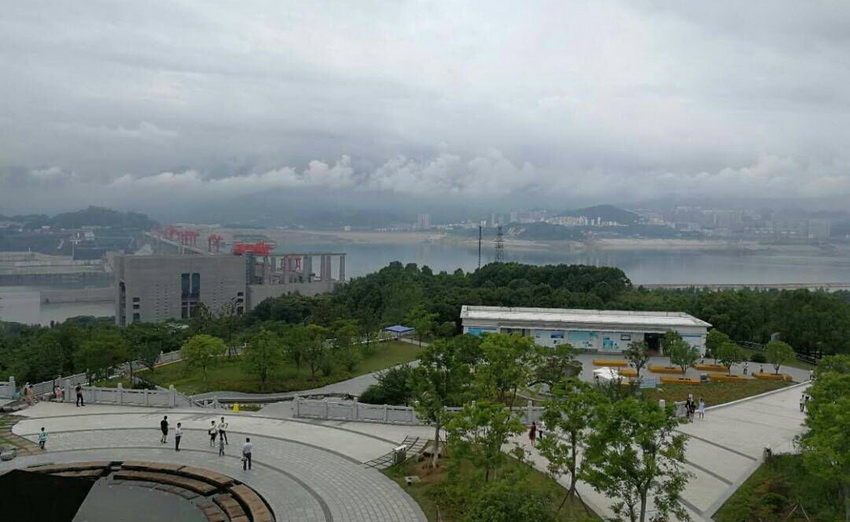


YICHANG, Hubei province - As an engineering wonder of the modern age by China, the Three Gorges Dam, is one of the largest dams in the world. One can feel the importance and essence of this engineering wonder, which was built on the Yangtze River to not only produce energy, but to reduce the potential for floods downstream by providing flood storage space.
With world’s largest power station in terms of installed capacity (22,500 MW), the Three Gorges Dam is the largest and most powerful hydroelectric project in the world.
Journalists from South Asia and South East Asia recently had an opportunity to visit this gigantic dam, which stretches almost 1.4 miles in length and is 185 meters tall.
In a briefing to the journalists, officials said that the 17-year-long construction project was divided into three phases, and that the dam has 32 generators.
The first phase of the dam (1993-1997) witnessed the historic closure of the Yangtze River, while the second phase (1998-2003) was symbolized by the impoundment of the reservoir to 135 meters for the commencement of power generation of the first group of generating units and the operation of the two-way five-gate ship lock.
The third phase (2004-2009) was characterized by the commissioning of all generating units in the left and right bank power houses.

Historical records show that during 2,000 years of history, the 6,300 km long Yangtze River witnessed 214 devastating floods averaging every 10 years.
In 1931, severe flooding engulfed the middle and lower reaches of the Yangtze River, killing 145,000 people, while in 1935, devastating floods swept across 53 counties and cities on the Jianghan plain, killing 142,000 people. In 1954, a serious flood disrupted the Beijing-Guangzhou Railway for more than 100 days, claiming hundreds of lives.
In 1998, a major flood in the middle and lower reaches of the Yangtze River resulted in the death of 1,562 people and economic losses of 2,300 billion RMB. The founder of modern China, Sun Yat-Sen, leader of China’s democratic revolution, had a vision of building the ambitious Three Gorges project, and during the 1940s, the Nationalist Government with the assistance of American experts made an engineering plan.
After the founding of the People’s Republic of China, the possibility for the project of Three Gorges Dam surfaced successfully. The Chinese Communist Party and state leaders worked with engineers to achieve the project.
Starting in the 1950s, tens of thousands of scientists and engineers participated in the feasibility study and design of project.
After the 1980s, the Central Government mobilized more than 400 distinguished experts to conduct scientific study for feasibility of the project. In 1992, 5th National People’s Congress adopted a historic resolution for the project.
The Chinese Government has been fulfilling four goals from this project: flood control, power generation, navigation, and tourism. The Dam has a flood control capacity of 22.15 billion cubic meters.
The China Three Gorges Dam has been producing about 84.6 billion kilowatt hours of clean energy annually. In 2016, the Dam successfully achieved its 175-meters impounding trial target for the seventh consecutive year, with prominent benefits for power stations.
The Dam has two power houses with 32 power generators installed there. Each generator can produce 700 MW of electricity. Six other dams have also been constructed on Yangzi River. The Chinese government has made a “one in 1,000-year flood” plan.
The Dam is built in a way that ships carrying goods can easily pass.

Since the Dam started operation in 1993, the China Three Gorges Corporation (CTG), the world leading company in power house construction, has built four large scale hydro power stations: Xiluodu Dam, Xiangjiaba Dam, Wudongde Dam, and Baihetan Dam at the lower reaches of the Jinsha River.
CTG has become the world leader in the production of renewable energy, backed by a 35,000-strong workforce people and total assets of 654.8 billion RMB. The group specializes in hydropower development and operation, as well as in the development of wind and solar power in China and abroad.
CTG has established a professional management team offering consulting services under which they have completed power development cooperation and planning in South Africa.
It also provided planning of wind power in four coastal provinces in Myanmar and consulting services for the operation management of Murum Hydropower Station in Malaysia.
CTG has been engaged in optimizing basin planning for Pakistan at the Karot Hydropower Station on the Jhelum River. It is providing strong energy support for China-Pakistan Economic Corridor (CPEC) projects, a flag carrier project of the Belt and Road Initiative. The company is also constructing the Quaid-e-Azam Solar Power Park (100 MW) in Pakistan’s Punjab province.
In Brazil, they are increasing asset utilization, improving maintenance planning, and refining demand management for existing assets in Brazil.
By 2022, 120 large hydropower generating units with a capacity of greater than 700 MW each will have been built around the world, and over 80 of them will be operated and managed by CTG.

The author
Raza Khan is a reporter of the Dawn News, and currently an intern with the People's Daily Online.

 Award-winning photos show poverty reduction achievements in NE China's Jilin province
Award-winning photos show poverty reduction achievements in NE China's Jilin province People dance to greet advent of New Year in Ameiqituo Town, Guizhou
People dance to greet advent of New Year in Ameiqituo Town, Guizhou Fire brigade in Shanghai holds group wedding
Fire brigade in Shanghai holds group wedding Tourists enjoy ice sculptures in Datan Town, north China
Tourists enjoy ice sculptures in Datan Town, north China Sunset scenery of Dayan Pagoda in Xi'an
Sunset scenery of Dayan Pagoda in Xi'an Tourists have fun at scenic spot in Nanlong Town, NW China
Tourists have fun at scenic spot in Nanlong Town, NW China Harbin attracts tourists by making best use of ice in winter
Harbin attracts tourists by making best use of ice in winter In pics: FIS Alpine Ski Women's World Cup Slalom
In pics: FIS Alpine Ski Women's World Cup Slalom Black-necked cranes rest at reservoir in Lhunzhub County, Lhasa
Black-necked cranes rest at reservoir in Lhunzhub County, Lhasa China's FAST telescope will be available to foreign scientists in April
China's FAST telescope will be available to foreign scientists in April